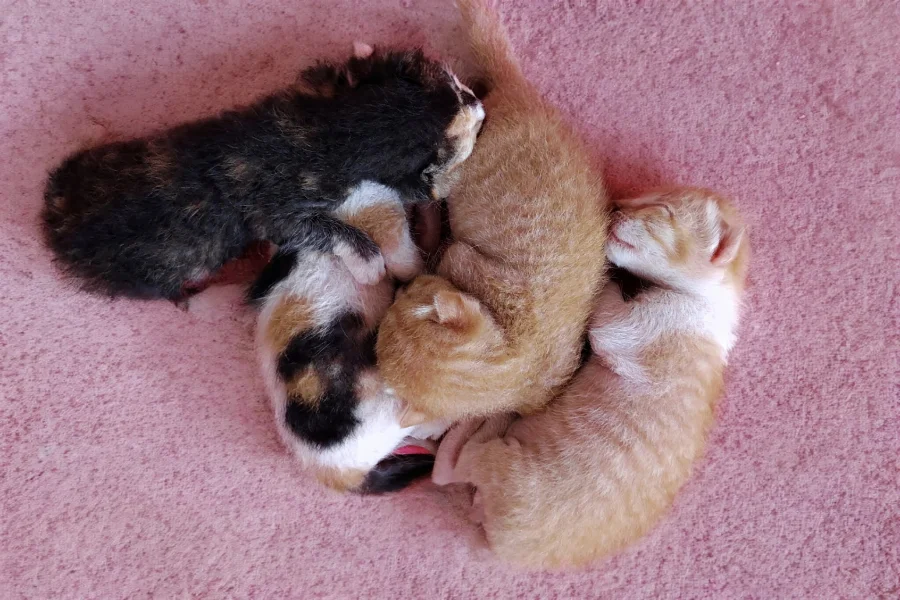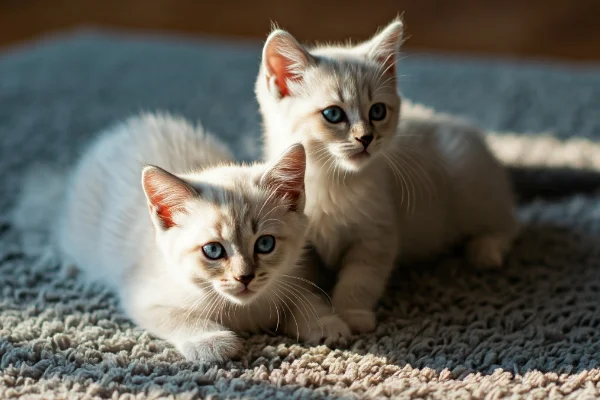
We may earn a commission when you purchase via our links at no extra cost to you.
We only share resources that meet our high standards
What is kitten separation anxiety?
Kitten separation anxiety is persistent distress a kitten shows when separated from its caregiver. It can include vocalizing, destructive behavior, loss of appetite, overgrooming, and clinginess. Use a stepwise program (space, routine, desensitization, play, calming aids, socialization, monitoring) to reduce kitten anxiety and build confident independence.
No matter you’re a beginner or experienced cat owner — these steps are simple, evidence-based, and written for new cat parents who want results without harsh methods.
Signs & symptoms to watch for
Know the difference between normal protest and anxiety that needs active help.
Behavioral signs
- Persistent, loud meowing or crying when you leave.
- Shadowing you constantly and panicking when you prepare to leave (pacing, hiding).
- Destructive activity only when left alone (scratching doors, chewing cords).
Physical signs
- Loss of appetite or vomiting.
- Overgrooming or bare patches.
- Litter-box changes (going outside the box under stress).
Contextual clues
- The kitten calms when you stay but becomes frantic the moment you gather keys, coat, or shoes.
- Reactions escalate over days or weeks rather than fading.
Quick comparison: normal vs anxiety
| Normal Kitten Behavior | Anxiety Red Flag |
| Short whine when left alone, settles quickly | Continuous loud meowing for >30 minutes |
| Occasional chewing of toys | Systematic destruction of furniture or cords |
| Short-lived loss of appetite | Refusal to eat for 24+ hours |
If you notice severe physical changes (not eating, bleeding, extreme self-injury), contact your vet immediately.
Quick safety & medical checklist
Before behavior modification, rule out medical causes. Pain, digestive upset, or neurological issues can look like anxiety. A quick vet visit rules these out and ensures your plan targets behavior, not illness.
The 7-Step Guide to handling kitten separation anxiety
Step 1 — Create a predictable, safe “home base”
Set up a comfortable single room or corner where your kitten has a bed, clean litter, food/water, hiding spot, and safe toys. Keep the layout consistent so the space becomes associated with security. Use a small cat bed, towel with your scent, and a few favorite toys.
Why: Predictability lowers baseline stress and gives the kitten a place they can return to when scared.
Step 2 — Build a consistent leaving and return routine
Keep departures and arrivals low key. Avoid drama: no long goodbyes, no excited greetings. Create a simple cue routine (putting on shoes, grabbing keys) and perform it without leaving sometimes — this reduces the cue’s power.
Why: Predictability in your behavior reduces anticipatory panic.
Step 3 — Use gradual desensitization (short departures that expand)
Start with very short absences: close the door for 30 seconds, then return and reward calm behavior. Slowly increase to 1–2 minutes, then 10, and so on. If the kitten becomes distressed, shorten the step and progress more slowly.
Why: Small wins teach the kitten that alone time is safe and temporary.
Step 4 — Increase mental and physical stimulation before alone time
Engage in 5–10 minutes of vigorous play immediately before you leave. Offer a puzzle feeder or a timed treat dispenser that will provide food while you’re gone.
Why: A tired, mentally stimulated kitten is likelier to nap than panic.
Step 5 — Introduce comforting environmental aids
Pheromone diffusers, soft background noise (low-volume radio), and “heartbeat” toys can reduce acute stress. Place a piece of your worn clothing in the bed so your scent is present.
Why: Environmental cues can mimic comfort and lower arousal levels when you’re absent.
Step 6 — Practice socialization and independent behaviors
Encourage short, positive interactions with visitors (quiet, treats, calm handling). Teach self-soothing — hide treats around their space, play “independent” fetch with soft toys, and reward the kitten when they settle alone.
Why: Social confidence and practiced independence reduce the likelihood of separation responses.
Step 7 — Monitor, adapt, and use independence games
Keep a simple log: how long you left, what the kitten did, and progress notes. If progress stalls, change techniques — more gradual steps, different toys, or more pre-leave play. Use games that reward independent play (e.g., set up a foraging trail).
Why: Tracking helps you see small improvements and adjust the plan responsibly.
Natural & practical tools: what helps (and what to avoid)
Helpful: puzzle feeders, interactive toys, pheromone diffusers (Feliway-style), soft sound, worn clothing, timed treat dispensers.
Avoid: punishments, scolding, or forcing prolonged separations suddenly. These can worsen anxiety.
If you consider calming supplements, choose vet-approved, evidence-based products and talk to your veterinarian before use. For practical do-and-don’t tips on managing separation-related behavior, the ASPCA provides clear, accessible guidance for owners
Common mistakes & how to avoid them
- Punishing vocalizing. It increases fear and undermines trust.
- Inconsistent routines. Mixed signals confuse kittens; consistency speeds learning.
- Overcompensating with constant carrying. It prevents practice at being alone. Balance affection with structured independence practice.
When to seek professional help
Seek veterinary or behaviorist help if:
- Your kitten stops eating for 24+ hours.
- Self-injury or severe destructive behavior occurs.
- No improvement after 4–6 weeks of steady training.
Scientific reviews and clinical reports document cases where professional intervention was needed; a veterinarian can check medical causes and, if necessary, refer you to a certified feline behaviorist.
| Approach | Pros | Cons |
| Gradual behavior training (7 steps) | Builds lasting confidence; few side effects | Requires patience and consistency |
| Immediate heavy intervention (boarding, long sedatives) | Quick short-term calm | Doesn’t teach independence; potential side effects |
FAQs
Do kittens grow out of separation anxiety?
Many do with patient training; some need structured intervention. Early, consistent work speeds recovery.
How long can I safely leave a kitten?
Young kittens should not be left alone all day. For social and physical needs, limit long absences and ensure safe enrichment if you must be away.
Will getting a second kitten help?
A companion can reduce loneliness but may also create a pair that’s more anxious together. Introduce carefully and only if you can commit to two.
Are pheromones safe and effective?
Often helpful for mild stress. They’re non-invasive but work best combined with behavior training.
When are medications recommended?
Only after vet assessment and usually as a short-term aid while behavior modification proceeds.
How fast should I see improvement?
You may see small gains within 1–2 weeks; measurable progress typically occurs over 4–8 weeks with consistent practice.
Key takeaways
- Create a reliable, calm home base and routine.
- Progress in small, consistent steps — short departures that increase.
- Use play, puzzle feeders, and calming aids to reduce stress before alone time.
- Track progress and consult a vet/behaviorist if severe or no improvement.
Next steps
Try Steps 1–3 for two weeks: set up a safe space, normalize departures, and practice short absences. Log your kitten’s reactions and build up slowly. If things don’t improve, contact your veterinarian for a medical check and behavioral referral.
Understand your kitten better, read our article collections here: How to Socialize a Kitten and How to Calm Your Stressed Cat Naturally


